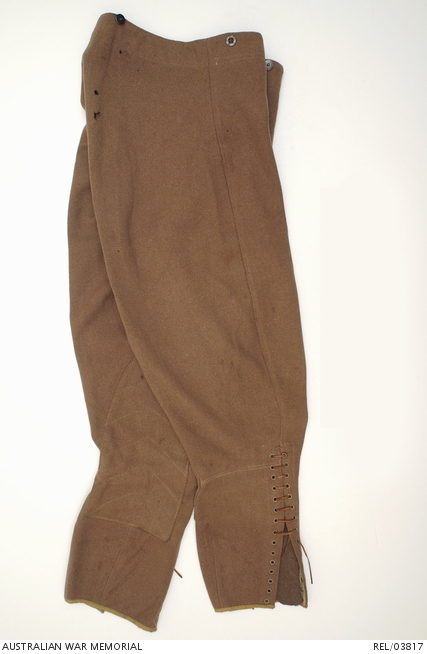| Place | Middle East: Ottoman Empire, Palestine |
|---|---|
| Accession Number | REL/03817 |
| Collection type | Heraldry |
| Object type | Uniform |
| Physical description | Cotton twill, Leather, Metal, Wool twill |
| Maker |
Military contractor |
| Date made | c 1914-1919 |
| Conflict |
First World War, 1914-1918 |
Breeches : Private G R Kenihan, 5 Light Horse Field Ambulance, AIF

Other ranks khaki woollen cord breeches. Self fabric panels with chevron-patterned stitching have been sewn onto both inner legs for reinforcement. The breeches have a concealed fly with four black pressed metal buttons, with a larger button at the waist. There are six further pressed metal buttons located around the outside of the waistband for the attachment of braces; five of these have been riveted on. There are 15 pairs of metal eyelets fitted with fine brown leather thong laces on the outside of both of the leg cuffs. The breeches have pockets on each side of the front, which are concealed inside the waistband. The cuffs and fly are lined with khaki cotton twill. The inside waist and pocket bags are of plain weave khaki cotton. '18885 / SIZE 2(?)' has been stamped on the inside rear in black. A checker's purple coloured stamp is printed on the front of the right hand pocket lining.
16968 Private George Roe Kenihan, who was born at Baroota, South Australia, enlisted in the AIF in Adelaide, on 6 July 1916. He was assigned to the Army Medical Corps and was sent to Seymour in Victoria to undertake specialist medical training. On completion of the course he was assigned to the reinforcements for the Camel Corps Field Ambulance in Palestine. Kenihan left Melbourne for Egypt aboard HMAT A42 Boorara on 10 May 1917. On arrival in Egypt he was transferred to 4 Light Horse Regiment Field Ambulance. He helped to treat the wounded after the Australian charge at Beersheba on 31 October 1917. In September 1918 Kenihan was transferred to 5 Light Horse Field Ambulance, and it was while he was serving with this unit that he took part in the formal Australian entry into Damascus on 2 October 1918. He returned to Australia on 14 July 1919.
Related information
Conflicts
Subjects
Related Objects
- Kenihan, George R (Private, 5th Fld Amb)
- Service dress tunic : Private G R Kenihan, 5 Light Horse Field Ambulance, AIF
- Khaki fur felt slouch hat : Private G R Kenihan, 5 Light Horse Field Ambulance, AIF
- Pair of brown leather leggings : Private G R Kenihan, 5 Light Horse Field Ambulance, AIF
- Medical kit in leather pouch : Private G R Kenihan, 4 Light Horse Field Ambulance, AIF
- Wallet : Private G R Kenihan, 4 Light Horse Field Ambulance, AIF
- Turkish Red Crescent armband : Private G R Kenihan, 4 Light Horse Field Ambulance, AIF